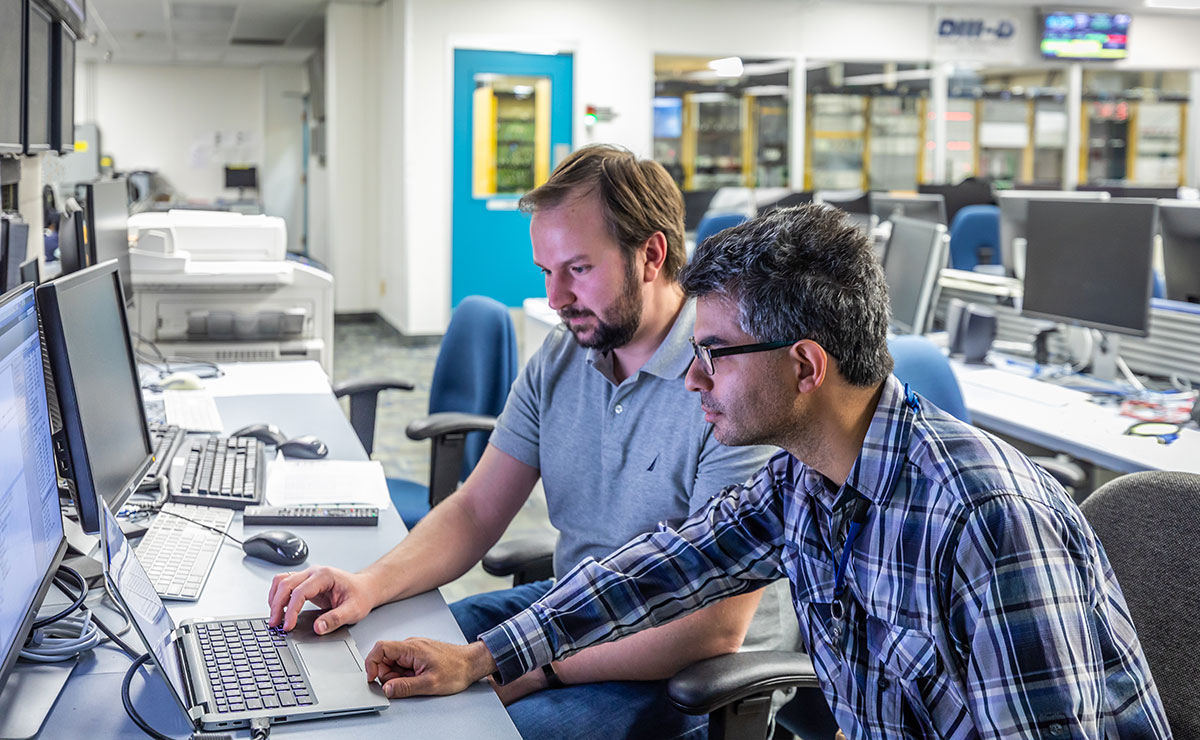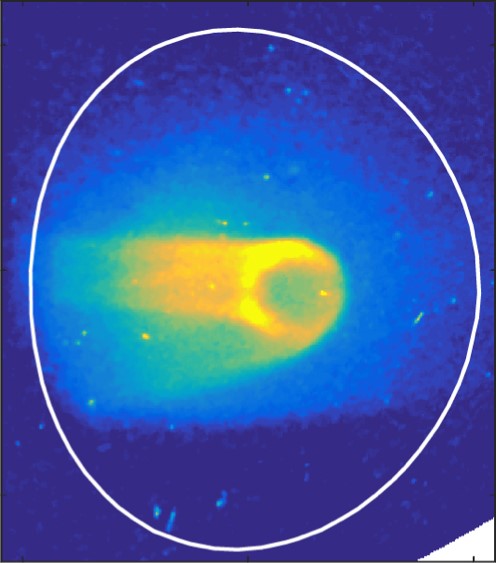DIII-D Scientists Solve Key Challenge for Controlling "Runaway" Electrons in Fusion Plasmas

Discovery could help control potentially damaging bursts during plasma disruptions
San Diego, April 6, 2020 – Scientists at the DIII-D National Fusion Facility have made an important discovery that could significantly improve the reliability of future fusion power plants by helping prevent damaging phenomena known as “runaway” electrons (REs). The research, published in an article today in the journal Nuclear Fusion, discovered new mechanisms that dissipate REs through exploitation of resonances that occur between the high-energy electrons and the magnetic field configuration.
This improved understanding of RE behavior suggests a pathway toward controlling them in large fusion devices known as tokamaks, such as the ITER experiment under construction in France and the commercial power plants that will follow it.
“Runaway electron beams are a significant challenge for tokamak operation because of their potential to seriously damage the walls of the device,” said Andrey Lvovskiy, who led the multi-institutional team at DIII-D. “To control their impacts on ITER, we need better information about their behavior and effects.”
DIII-D, which General Atomics operates as a national user facility for the Department of Energy’s Office of Science, hosts researchers from more than 100 institutions across the globe, including 40 universities. The heart of the facility is a tokamak that uses powerful electromagnets to produce a doughnut-shaped magnetic field for confining a fusion plasma. Plasma is the “fourth state of matter” in which electrons are stripped from the nuclei of their atoms, leaving charged ions that are confined by the magnetic fields. (See Fusion Energy 101 explainer below for more detail on how fusion works.)
In DIII-D, plasma temperatures several times hotter than the Sun are routinely achieved. At such extremely high temperatures, hydrogen isotopes can fuse together and release energy.
However, certain conditions in a tokamak can cause a loss of plasma confinement, known as a disruption. These disruptions can separate an existing population of confined, energetic electrons, which are further accelerated to nearly the speed of light by the quenching plasma. These high-energy particles, known as “runaway” electrons, can cause significant damage to materials that they encounter.
In current tokamaks, the potential damage is rarely a threat to operation. The much larger size and current of future power-plant scale reactors, including ITER, means the damage potential there is greater. However, the complex physics of RE beams makes predicting the degree of impact difficult.

To improve understanding, the DIII-D team intentionally created and maintained a RE beam at low current and impurity content. Using an ultrafast gamma-ray detector, they were able to measure the gamma radiation from the RE beam to determine the energy, number, and spatial distribution of the REs. They were also able to measure the current distribution inside the RE beam, which is an important element in understanding the beam’s stability.
The results suggest that REs may excite kinetic instabilities in the plasma that both drain energy from the runaway electron population and act to redirect some electrons so that they are lost from the runaway beam before reaching very high energy. This points toward a method to control REs and mitigate potential damage to the tokamak walls, though further work on detection and exploitation of RE-driven instabilities is necessary. The team is continuing its research in this area, as RE-driven kinetic instabilities have been an active area of study over the past few years at DIII-D.
Another novel result from these studies is the measurement of the current distribution inside the RE beam. Theoretical models predict that the RE beam can have a “peaked” current profile, that is, its current is concentrated in the center of the beam. Such a profile can destabilize the beam and cause magnetohydrodynamic (MHD) instabilities (those driven by plasma current and pressure), which worsen the confinement of REs.
The experiments on DIII-D confirmed these theoretical models, observing both the predicted peaking of the RE current profile and associated impact. Scientists further showed that, by increasing the RE current, they could deliberately produce MHD instabilities and destabilize the beam. It is still unclear whether this effect will be advantageous or a problem in future fusion devices operating at high current, as an uncontrolled instability could cause both significant loss of REs and potential damage to the chamber walls. Thus, further work on mitigation and control techniques is necessary.
“These discoveries are very important for our understanding of the physics of runaway electrons,” said David Hill, Director of DIII-D. “The research is one more example of how collaboration between research institutions is essential for the progress of fusion science.”
The work, part of DOE’s Frontier Science Campaign that funds research relevant to both fusion and general plasma science, involved researchers from Oak Ridge Associated Universities, General Atomics, the University of Milano-Bicocca, the University of California San Diego, and Oak Ridge National Laboratory.
About General Atomics: General Atomics pioneers technologies with the potential to change the world. Since the dawn of the atomic age, GA’s innovations have advanced the state of the art across the full spectrum of science and technology – from nuclear energy and defense to medicine and high-performance computing. Behind a talented global team of scientists, engineers, and professionals, GA delivers safe, sustainable, and economical solutions to meet growing global demands.
About the DIII-D National Fusion Facility. DIII-D is the largest magnetic fusion research facility in the U.S. and has been the site of numerous pioneering contributions to the development of fusion energy science. DIII-D continues the drive toward practical fusion energy with critical research conducted in collaboration with more than 600 scientists representing over 100 institutions worldwide. For more information, visit www.ga.com/diii-d.
For more information contact:
Zabrina Johal
858-455-4004
Zabrina.Johal@ga.com
Fusion Energy 101
- Nuclear fusion occurs when light elements such as hydrogen are brought together at extremely high temperatures and pressures, causing the nuclei to fuse into heavier elements such as helium. This process powers stars like our sun and releases vast amounts of energy.
- Fusion differs from nuclear fission, where heavy elements split into lighter elements, releasing energy. Fission is the process used in existing commercial nuclear power plants.
- Fusion power plants will be fueled by a mixture of hydrogen isotopes: deuterium (the nucleus comprises a proton and a neutron) and tritium (the nucleus comprises a proton and two neutrons).
- Deuterium can be extracted from seawater and tritium can be created from small amounts of lithium in the reactor, making fusion a nearly limitless, carbon-free source of energy that leaves no long-lived radioactive waste.
- One way to achieve fusion on earth is in a tokamak (a doughnut-shaped metal vacuum chamber) surrounded by extremely powerful magnets that create strong magnetic fields.
- Creating fusion in a tokamak requires that the fuel be converted into a plasma by heating it to over 100 million degrees.
- Plasma is the “fourth state of matter” in which electrons are stripped from the nuclei of their atoms. This creates an electric charge that allows the plasma to be confined by the magnetic fields within the tokamak without touching the inside walls.
- Plasma is the most common state of matter in the universe. It can be seen all around us in places such as the stars, lightning, and fluorescent light bulbs.
- Tokamaks are inherently safe – any loss of control causes the plasma to touch the inside wall, immediately cooling it and stopping the fusion reaction.